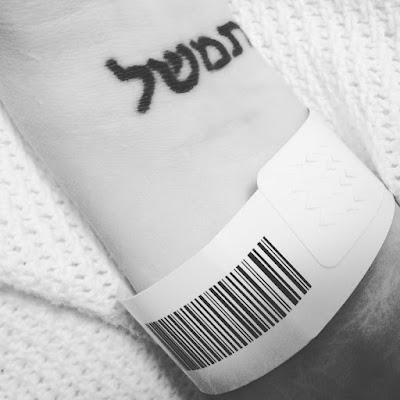In the world of mental health, they like their 3-letter initialisms: CBT (Cognitive Behavioural Therapy), CPA (Care Program Approach), CPN (Community Psychiatric Nurse), CBA (Wait, no, that one's just me!). I could write about my experience of all of those, but today I thought I'd share a little about a different three lettered title - the CTO - and what it meant to me.
What
A Compulsory Treatment Order - or CTO - is a power set out by the Mental Health Act (Scotland) 2003 which allows for a person with a mental health disorder to be treated for their condition, with or without their permission. It is similar to a short term detention - or 'section' - with which people are perhaps more familiar, but while a short term detention certificate allows for a 28 day window of care, the CTO allows for six months of compulsory treatment, with the possibility of a further six month extension, latterly followed by extension periods of a year at a time.The treatment which is permitted by a CTO certificate is set out under strict guidelines and will vary depending on the needs of the patient and whether the certificate granted is for a hospital or community-based CTO. A hospital-based CTO allows for a person to be detained in a hospital (possibly against their will) for its duration, where they will receive the treatment deemed necessary for them. A community-based CTO, meanwhile, allows for a person to live at home - away from hospital - but stipulates that they must be compliant with the treatment laid out for them. Failure to do so may result in the patient being admitted to hospital for assessment or treatment. In either case, treatment must specifically address the mental disorder itself, and can include "medication; talking therapies; training services; and services to promote social and independent living skills," while the CTO legally requires that a patient comply with certain conditions which may (but doesn't always) include the need to stay in hospital; to receive specified medical treatment; to attend for community care appointments; to allow members of the care team to visit at home; and, in some cases, to reside at a pre-determined address for its duration. In some situations, the CTO also allows for treatment of physical health conditions (against a person's will), under part 16 of the 2003 Act, if these conditions are deemed to be a direct result of the underlying mental disorder.
When
Before any of these powers can be granted, there is a strict application procedure to be followed, with every case being brought individually before the Mental Health Tribunal for consideration prior to a decision being made. An application must be submitted by a Mental Health Officer (a trained Social Worker) - including their own report, reports from two different doctors who have each examined the patient, and a proposed plan for treatment and care - and a meeting of the Tribunal will then be called. The Tribunal panel is made up of one lawyer, one psychiatrist and one "lay person" (who will have professional or personal experience of mental disorder) and it is up to them, having heard all the evidence, to decide whether or not to grant a CTO. In order to do so, they will hear - in person - from the MHO; the RMO (Responsible Medical Officer - usually the psychiatrist most involved in a patient's care); and any other connected professionals who have been called to speak. They will also take the patient's perspective into consideration, hearing from any or all of the following: the patient themselves; their advocate (a professional who helps to communicate the patient's own opinions); their named person (someone - usually a family member - given power to make decisions on their behalf); or a legal representative (usually a solicitor), for which they are entitled to legal aid under the Mental Health Act.Once they have heard from all parties, the Tribunal must assess the case considering the following criteria, as set out in the Act:
- The person has a mental disorder (i.e. a mental illness, learning disability or personality disorder).
- Medical treatment is available which will stop the condition getting worse, or help treat some of the symptoms.
- If that medical treatment was not provided, there would be a significant risk to the patient, or to any other person.
- Because of their mental disorder, ability to make decisions about medical treatment is significantly impaired.
- The use of compulsory powers is necessary.
Why
Essentially, the aim of the CTO is to allow the professionals to hold some of the responsibility and decision-making power during a time where the patient is deemed less able to do so, as a direct result of their mental disorder. It is ideally used for the shortest time period necessary, under constant review, and can be dropped (or allowed to lapse without reapplication if nearing its end) following discussion with the MHO and RMO when all five criteria are no longer met. Basically, a CTO is granted with the intention of keeping a person safe and restoring their mental well-being to such a place that they are able to take responsibility for their own treatment and equipped to make their own decisions once again.
How
How people experience the use of a CTO is widely varying. Though its intention is the same in every instance, its outworking can look very different. Even in similar circumstances, the people on whom it is used can have very different emotional experiences.For some, a CTO certificate feels a little like a prison sentence. It can keep a person "locked up" in hospital, or locked into a "contract" without much say; it can take away choice and responsibility; it can be dis-empowering; and it can feel like being trapped, with no escape.
For others, a CTO certificate feels very much like a safety-net. It provides a solid, structured framework for treatment that allows everyone to know where they stand; it distributes the responsibility for that treatment between more parties and allows the patient to carry less of the burden; and it provides reassurance that, when things go wrong, there is already a catching mechanism firmly in place. For these people, it works very well - they seem to thrive when the CTO comes into play.
Everyone is different and the story of their CTO will be unique. My story is just one example of many, but I plan to write about my own experience in the coming weeks. For now, I'll leave you guessing: do I fall into the "prison" or "safety-net" category, or am I one of many on the spectrum in between?
Oh the suspense! Watch this space...
★☆★
In the meantime, see the links below for more useful information on the issues discussed:
- 'A Guide to Compulsory Treatment Orders'
- 'A Guide to Emergency and Short-Term Powers'
- 'The Mental Health Act (Scotland) 2015'
- The Mental Health Tribunal for Scotland
- The Mental Welfare Commission for Scotland
xo










0 Comments